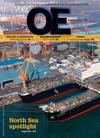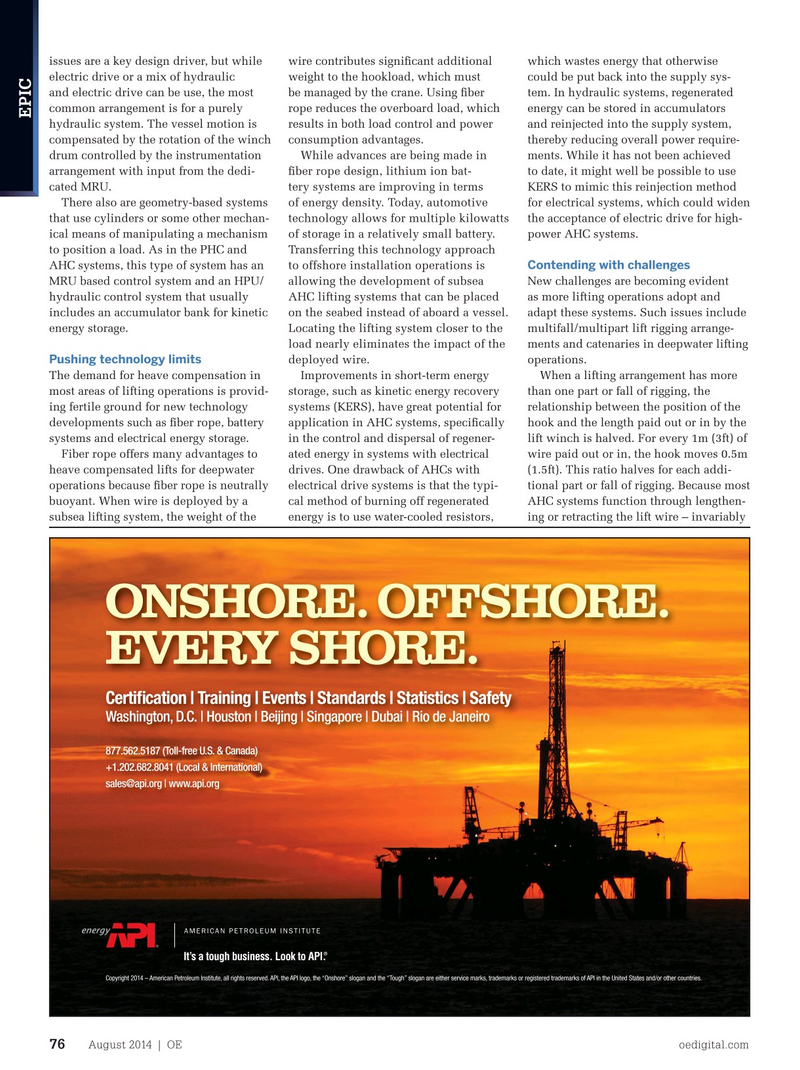
Page 74: of Offshore Engineer Magazine (Aug/Sep 2014)
Read this page in Pdf, Flash or Html5 edition of Aug/Sep 2014 Offshore Engineer Magazine
issues are a key design driver, but while wire contributes signifcant additional which wastes energy that otherwise electric drive or a mix of hydraulic weight to the hookload, which must could be put back into the supply sys- and electric drive can be use, the most be managed by the crane. Using fber tem. In hydraulic systems, regenerated common arrangement is for a purely rope reduces the overboard load, which energy can be stored in accumulators
EPIC hydraulic system. The vessel motion is results in both load control and power and reinjected into the supply system, compensated by the rotation of the winch consumption advantages. thereby reducing overall power require- drum controlled by the instrumentation While advances are being made in ments. While it has not been achieved arrangement with input from the dedi- fber rope design, lithium ion bat- to date, it might well be possible to use cated MRU. tery systems are improving in terms KERS to mimic this reinjection method
There also are geometry-based systems of energy density. Today, automotive for electrical systems, which could widen that use cylinders or some other mechan- technology allows for multiple kilowatts the acceptance of electric drive for high- ical means of manipulating a mechanism of storage in a relatively small battery. power AHC systems.
to position a load. As in the PHC and Transferring this technology approach
Contending with challenges
AHC systems, this type of system has an to offshore installation operations is
MRU based control system and an HPU/ allowing the development of subsea New challenges are becoming evident hydraulic control system that usually AHC lifting systems that can be placed as more lifting operations adopt and includes an accumulator bank for kinetic on the seabed instead of aboard a vessel. adapt these systems. Such issues include energy storage. Locating the lifting system closer to the multifall/multipart lift rigging arrange- load nearly eliminates the impact of the ments and catenaries in deepwater lifting
Pushing technology limits deployed wire. operations.
The demand for heave compensation in Improvements in short-term energy When a lifting arrangement has more most areas of lifting operations is provid- storage, such as kinetic energy recovery than one part or fall of rigging, the ing fertile ground for new technology systems (KERS), have great potential for relationship between the position of the developments such as fber rope, battery application in AHC systems, specifcally hook and the length paid out or in by the systems and electrical energy storage. in the control and dispersal of regener- lift winch is halved. For every 1m (3ft) of
Fiber rope offers many advantages to ated energy in systems with electrical wire paid out or in, the hook moves 0.5m heave compensated lifts for deepwater drives. One drawback of AHCs with (1.5ft). This ratio halves for each addi- operations because fber rope is neutrally electrical drive systems is that the typi- tional part or fall of rigging. Because most buoyant. When wire is deployed by a cal method of burning off regenerated AHC systems function through lengthen- subsea lifting system, the weight of the energy is to use water-cooled resistors, ing or retracting the lift wire – invariably
ONSHORE. OFFSHORE.
EVERY SHORE.
Certi? cation | Training | Events | Standards | Statistics | Safety
Washington, D.C. | Houston | Beijing | Singapore | Dubai | Rio de Janeiro 877.562.5187 (Toll-free U.S. & Canada) +1.202.682.8041 (Local & International) [email protected] | www.api.org ®
It’s a tough business. Look to API.
Copyright 2014 – American Petroleum Institute, all rights reserved. API, the API logo, the “Onshore” slogan and the “Tough” slogan are either service marks, trademarks or registered trademarks of API in the United States and/or other countries.
OffshoreEngineering_HalfPageAd2.indd 1 2/10/14 10:36 AM
August 2014 | OE oedigital.com 76 072_OE0814_EPIC5_ABS.indd 76 7/22/14 9:21 PM

 73
73

 75
75